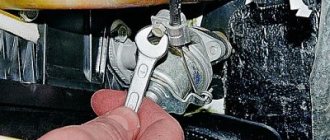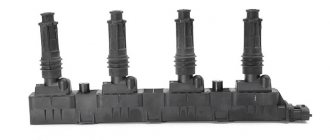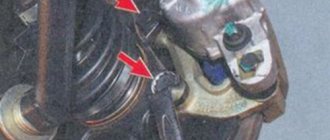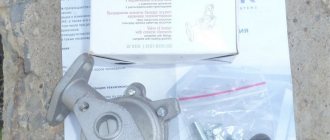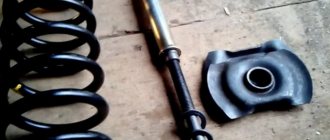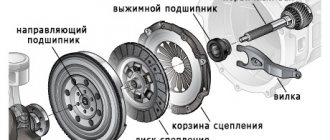Extraneous sounds always indicate that some problems have arisen. Especially if the noise comes from under the hood. Drivers are especially concerned about sudden strong impacts. This is how the chain guide on a VAZ 2107 behaves when it fails.
It is dangerous to continue driving with a broken damper. This will lead to rapid wear of the guide teeth on the sprockets, which will damage the links of the chain itself. As a result, serious engine damage.
Our instructions will help you understand the structure and features of replacing this important element of the car's design.
Purpose of the sedative
The damper is designed to dampen vibrations and jerks that occur during startup on the timing chain. Without this device, the chain would easily break off the guide gears and break at the most inopportune moments.
Most often, the timing chain breaks at the moment when the crankshaft rotation speed reaches its maximum. The break occurs so quickly that the driver has no chance to react in time and turn off the engine. As a result, all engine valves fail.
After the valves, problems begin in the cylinders. It is almost impossible to restore the engine after such a breakdown. Especially when it comes to seven. After all, the cost of repair work can significantly exceed the cost of the entire car. And it’s easier to sell a car for spare parts than to restore the engine.
Therefore, we can conclude that the timing chain guide is one of those parts that needs constant monitoring. This is the most important protection of your engine from major breakdown.
Signs and causes of chain drive malfunction
The timing chain drive, unlike the belt drive, is located inside the engine and in order to assess the condition of the elements, partial disassembly of the power unit will be required. There are certain signs that indicate that not everything is in order with the chain drive and it needs to be tensioned or replaced.
The chain rattles
Problems with the circuit may manifest themselves as follows:
- rattles when cold;
- knocks on hot;
- there is extraneous noise during load;
- constant metallic sound.
If extraneous noise appears, it is recommended to visit a service station in the near future or independently deal with the problems in the timing drive and evaluate the condition of all elements responsible for its operation (tensioner, shoe, damper, chain, gears). If you continue to drive a car with a rattling chain, wear on parts increases.
Due to damage or breakdown of timing drive elements, the chain may rattle
The main reasons that lead to failure of timing belt components are:
- failure to promptly change the engine oil or use a brand other than that recommended by the manufacturer;
- use of low quality spare parts (non-original);
- low engine oil level or low pressure;
- untimely maintenance;
- improper operation;
- poor quality repairs.
One of the likely reasons that the chain begins to rattle is its stretching and a malfunction of the tensioner. As a result, the chain drive cannot be tensioned properly, and a uniform noise appears in the motor, similar to the operation of a diesel engine. In most cases, the sound is heard when idling on a cold engine.
Video: why the chain rattles on a “classic”
Jumped the chain
With low tension, the chain stretches quite quickly and can jump on the gear teeth. This is possible as a result of a broken shoe, tensioner or damper. If the chain has jumped, then a strong ignition bias occurs. In this case, it is necessary to troubleshoot the drive parts of the gas distribution mechanism.
Mechanism design
This is a simple plate made of high quality carbon steel. It has two mounting holes.
There is also a second design element. It is called the hydraulic tensioner shoe. It is located under the timing cover. To extend service life, the side exposed to increased mechanical stress is coated with durable polymer material.
To replace the chain guide on a VAZ, you need to remove the cover and loosen the tension roller.
Video “Chain Knocking on a Classic”
Replacing the hydraulic chain tensioner on a Chevrolet Niva with a manual one
https://youtube.com/watch?v=L27fdFKEj-U
This video examines the cause of engine knocking and demonstrates chain drive tension.
A VAZ 2107 timing chain tensioner is installed on the front right side of the car engine. The main purpose of such a mechanism is to tension the chain, which in turn is extended during operation.
Replacement work is not difficult and is completed within a short period of time. To replace the tensioner you must:
- Open the hood of the car and in the engine compartment, use a ten-point socket wrench to unscrew the two bolts securing the tensioner to the cylinder block and carefully remove it. A sealing gasket will be installed between the tensioner and the block. Check its condition and, if necessary, replace it with a new one.
- Having removed the tensioner body, we clamp it in a vice and use a thirteen key to unscrew the central cap nut, thereby checking the serviceability of the collet lock. If a crack is detected, it is necessary to replace the cap or the tensioner itself.
After checking the tensioner and if it needed to be replaced, you can begin installation. Before installing it, the tensioner must be charged; to do this, push the plunger all the way in and, holding it in this state, tighten the cap nut.
I tighten the cap nut, install the tensioner in its place and tighten the bolts that secure it. Then we turn the crankshaft one turn, thereby tightening the camshaft drive chain, after which we release the cap nut, releasing the tensioner, and tighten it again. At this point, the repair work to replace the timing chain tensioner of the VAZ 2107 is completed.
Sometimes a car enthusiast encounters extraneous sounds that come from the area of the front engine cover and resemble a kind of tapping. This may be a sign that the chain guide needs to be replaced. The damper on the VAZ 2107 model is necessary to soften the vibrations of the chain during its rotation. If you can clearly hear a clattering or metallic tapping sound, this means that the damper is very worn and needs to be urgently replaced. Another possible cause of the problem is that the chain tension is too loose. In this car model, the damper is located on the left, in front of the cylinder block. Use the diagram supplied with the machine to determine the exact location of the part to be replaced.
Replacing a chain guide on a VAZ 2107 is not a complicated procedure. Each driver will be able to carry out such an operation independently if he takes into account several important points. When replacing a part yourself, you need to proceed like this.
The long fastening bolt is installed at the top, and the short one at the bottom. If the bolts have a significant degree of wear, they need to be replaced, otherwise even after replacing the damper, the characteristic tapping sound may remain.
If the damper simply breaks into pieces while moving, you need to remove all its components. Sometimes this is quite difficult to do and you have to invent various devices to get the debris out. In such a situation, a magnet attached to the end of a long wire can help out. Place all the removed parts together to determine if there is anything left inside.
Do not buy the parts needed for replacement at a service station - there they will cost 1.5-2 times more than at the car market or in a specialized store.
Operating principle of the chain damper
When you start the engine, you force the crankshaft and timing shaft to move. Ideally they should work synchronously. But it doesn't always happen this way. The teeth on the guide gears sometimes break, and the chain stretches and begins to sag.
This leads to the fact that the timing shaft begins to move a few moments after the crankshaft. The chain stretches even more and can easily come off the gear.
That is why cars are equipped with a so-called calming system, which consists of two parts.
This is what a sedative looks like
The shoe is connected to an oil line containing an oil pressure sensor. If the chain slack reaches a high value, the lubricant pressure drops sharply. This results in an additional volume of oil being pumped in, which allows for additional pressure to be created.
The shoe moves and transmits pressure, bringing the tension state into order. All this happens instantly, which protects against circuit breaks.
But due to a sharp blow to the shoe, it begins to vibrate strongly. The vibrations are transmitted to the opposite side, where there is a damper designed to dampen them.
For what reasons can the chain guide on a VAZ-2107 fail?
Experienced car enthusiasts have noticed that the chain guide needs to be changed in several situations:
- When a knocking sound is heard in the area where the chain structure is located.
- When the chain oscillates.
- When the chain links jump over the teeth on the sprocket.
In the first situation, a loud knocking sound is heard from the side of the intermediate shaft cover. It will be evidence that the damper has broken.
Most often, such a part begins to break if the timing chain structure is weakened.
Another reason for the breakdown of this part may be the result of accidentally unscrewing the nut at the place of its fastening. Unscrewing of the nuts occurs due to increased vibration of the running engine. This is due to the location of the part in question:
- opposite the timing chain tensioner shoe;
- secured with two bolts of different lengths.
Signs of a malfunctioning damper
The driver can judge the breakdown by two characteristic signals:
- Strong knocks and grinding noises that are heard under the timing cover. Unpleasant sounds occur when the engine starts, especially if it is cooled.
- The motor loses momentum. This is especially noticeable until it warms up. A non-working part is not able to dampen vibrations, which leads to desynchronization in the operation of the cylinders. The engine behaves inappropriately, does not respond to the gas pedal, and failures occur.
Timing chain jump and its symptoms
The chain, like any other part of the car, wears out over time. Wear usually shows up as chain stretching. The cause of stretching is the so-called metal fatigue, which affects almost all parts that experience cyclic loads. Having stretched, the chain begins to sag significantly. If the driver does nothing, then sooner or later a situation will arise when the chain on one of the sprockets jumps one or two teeth forward. After this, all valve timing in the engine will be disrupted, as will its operation. Here are the main signs of a skipped timing chain:
All these signs indicate that the timing chain has not only weakened, but also jumped. And the driver needs to replace it as soon as possible. If this is not done, the engine will sooner or later seize, after which you will have to make expensive major repairs.
Why does it fail
The stabilizer on the VAZ 2107 faces serious loads throughout the entire engine operating cycle. No wonder it sometimes breaks down. There may be two reasons for this:
- Loosening the mounting bolts. Shocks continuously strike these bolts, causing them to become loose. Gradually becoming loose, the fastening element can easily break.
- Metal destruction. The mechanism is constantly running under voltage. Continuous impacts over time lead to the appearance of microcracks that are invisible to the naked eye. Gradually some of them are increasing. There comes a time when a spare part unexpectedly breaks down.
Why is the device replaced?
Do-it-yourself timing chain replacement
With prolonged use, the VAZ 2107 chain tensioner weakens (the spring loses its elasticity), which leads to improper operation of the device. This has a negative impact on the operation of the engine, since the valve timing gradually shifts, which contributes to increased heating and wear of the cylinder-piston group parts.
If it is no longer possible to tension the chain, then it may be time to replace the chain itself or one or both shoes, but perhaps only the VAZ 2107 chain tensioner has become unusable and you can only get by by replacing it, without expensive repairs. In the material we will consider the question of how to replace the chain tensioner on a VAZ 2107 car without affecting the tensioner shoe.
What is required for the work
To replace the tensioner on a VAZ 2107, you will need to use simple tools:
- Open-end wrenches for “10” and “13”.
- Key for turning the crankshaft.
After making sure that the above tools are available, you can begin work.
How much does a new product cost?
For the VAZ 2107, a tensioner from classic VAZ models is suitable, so you can choose any one that is available on the market. The average cost of this device is 600-700 rubles. Experienced drivers recommend giving preference to devices from the Tolyatti Automobile Plant, which are supplied in blue packaging. The package contains the packer's number, as well as a special sticker with a code underneath. If you send this code to the number, you will receive an SMS message with confirmation.
It is important to know! Purchase products only from certified stores to avoid purchasing counterfeits. The Pilot brand device also receives positive reviews
It has its advantages compared to the standard one, and at the same time it is considered maintenance-free and more reliable. Below is the packaging of ANC "Pilot"
The Pilot brand device is also receiving positive reviews. It has its advantages compared to the standard one, and at the same time it is considered maintenance-free and more reliable. Below is the packaging of the ANC “Pilot”.
Once the Pilot or standard chain tensioner has been purchased, you can proceed to the replacement procedure. The advantage of the “Pilot” is the fact that it is an automatic chain tensioner for the VAZ 2107, which independently regulates and maintains the degree of chain tension on the seven.
Product replacement principle
To replace a worn chain tensioner on a VAZ 2107 with a new one, you will need to perform the following steps:
The battery is removed from the car to provide access to the element being removed. The device is located on the right side of the front of the engine. Using a “10” wrench, you need to unscrew the 2 nuts securing the device. In the next step, we remove the device from the engine with our hands. We take a new tensioner, loosen the cover nut with a wrench to “13”, then press the protruding plunger into the tensioner itself until it stops, and tighten the same nut. To make this procedure easier, you can use a vice. This must be done to facilitate installation of the device into the engine. Once the device is installed, it can be installed in place, not forgetting about the gasket. We fasten the product using fastening nuts. The device is discharged; to do this, release the cap nut. At the same time, the plunger will become free and shoot, thereby causing a tight fit of the shoe to the chain. Using a 36-38 wrench or a pipe wrench, you need to turn the crankshaft clockwise 1.5-2 turns. At the moment of greatest resistance during rotation, we stop
It is important to ensure that the crankshaft remains in this position and does not move a millimeter against the stroke, otherwise the chain will sag. After this, you will need to tighten the cap nut tightly to “13”. Finally, start the engine and listen.
Repair of the tensioner on Lada cars is usually not carried out, so if it stops tensioning, it needs to be replaced. You can see the process of replacing the device in question in more detail in the video above.
How to replace a dampener
To work you will need:
- new part (cost approximately 500 rubles);
- 20 centimeters of one and a half millimeter steel wire;
- open-end and socket wrenches;
- flat screwdriver.
- Remove the air filter.
- Using a 13mm socket wrench, unscrew the mounting bolts on the cover. Remove the cover.
- Loosen the cap nut that secures the chain tensioner.
- Using a screwdriver, carefully press out the shoe and hold it in this position.
- Tighten the loose cap nut.
- Insert the wire hook into the eye of the damper.
- Unscrew the mounting bolts, holding the device itself with a hook so as not to drop it into the motor.
- After the mounting bolts have been removed, use a spanner to turn the timing shaft a third of a turn. This will release the chain tension.
- Using a steel hook, carefully remove the damper.
- Put a new one in its place.
- Follow steps 1 to 9 in reverse order.
So in a short time you can easily replace the damper in your garage, saving about 700 rubles. Usually this amount is asked to the service station for similar work.
What is needed to replace the VAZ 2107 damper
The set of necessary tools, parts and materials looks like this:
- Set of keys and socket heads.
- Screwdriver.
- Long tweezers, magnetic telescopic handle or stiff wire hook.
- Engine head cover gasket.
- Automotive sealant.
- New chain guide for VAZ 2107.
To replace the damper, an inspection pit or lift is not required. A little space and good lighting are enough. The work can be done both in the garage and on the street. In the latter case, you should avoid getting dust on the timing parts when the cover is removed.
Timing phases and when to set them according to marks
Valve timing refers to those moments at which the piston in the engine moves up and down over a certain interval. When irregularities in the valve timing occur, the pistons move incorrectly along the interval, resulting in uneven engine operation on the VAZ-2107.
If the driver notices that the car’s power decreases, fuel consumption increases, and engine interruptions occur, then it is necessary to resort to setting the valve timing according to marks. How to set marks on a VAZ 2107 carburetor and injector, we will learn from this material, since the design of the timing mechanism is identical.
How to set timing timing marks
The procedure involves performing the following manipulations:
- The VAZ 2107 needs to be placed on a hard surface, with chocks placed under the wheels and the hand brake pressed all the way. The gear shift lever must be set to neutral mode.
- The cover is removed from the cylinder head by first unscrewing all the fixing nuts to “10”. It is better to replace the gasket with a new one, even if the old one shows no signs of damage.
- Using a key set to “24”, you need to turn the crankshaft on a VAZ 2107 car. This is done in order to be able to align the marks on the moving and stationary parts of the mechanism. To carry out these actions, it is recommended to use good lighting or use a flashlight. The crankshaft rotates until the mark on the pump and generator drive belt pulley coincides with the long mark marked on the block.
- Combining these risks, the mark on the sprocket should eventually coincide with the ebb on the camshaft bed. If the mark ends up at the bottom, then you should rotate the crankshaft 360 degrees.
- If you can’t make sure the labels match, then proceed to the next steps, which are described below.
- The crankshaft is rotated until the marks on the star and the bed ebb align.
- Using the key at “13”, you need to loosen the tensioner. The 2 nuts securing the tensioner are unscrewed, after which this device is removed.
- The bolt that secures the sprocket to the camshaft is unscrewed. To do this you will need to use the key at “17”.
- The sprocket is removed, after which it must be rotated until the marks on the VAZ-2107 timing belt pulley coincide with the long mark on the block. The star fastening bolt does not need to be unscrewed, since after removing the tensioner the camshaft star rotates.
- We put a chain on the sprocket, if it was decided to unscrew it, and install it in place. Finally, the tensioner is installed, for which you should tighten it with 2 nuts to “10”. You can install the tensioner first, but later you will need to use a crowbar or pry bar to get the sprocket into place. Finally, screw the tensioner nut to “13”.
This relative arrangement of the parts allows the piston of the 4th cylinder to be positioned at top dead center TDC.
Features of servicing the timing mechanism
After the timing marks are installed on the VAZ-2107, you need to perform the following actions:
- The timing chain of the VAZ-2107 is being tensioned.
- Adjusting the valves, or more precisely, the thermal gap between the camshaft cams and the rocker arm.
- Setting up the ignition system.
The process of adjusting the valves on the VAZ-2107 is carried out according to the following scheme: initially 6 and 8 valves are adjusted, the report must be carried out from the radiator. After they are adjusted, you need to start adjusting valves 4 and 7, then valves 1 and 3, and finally valves 2 and 5.
How to adjust the valves on a VAZ-2107 car can be found out in more detail in the relevant material on this site. In conclusion, it is worth noting that VAZ-2107 cars are one of the most reliable vehicles, the production of which began back in the 90s.
Annotation on setting up the ignition system of the VAZ 2107 with your own hands
The Zhiguli “classic” VAZ 2107 does not belong to modern cars, manufactured with the latest technology and stuffed with sophisticated electronics. This is its beauty - there is no need to contact car service specialists for any reason; most of the car maintenance work can be done by the owner himself. This also includes the procedure for the ignition option, which anyone can perform, having previously studied the detailed instructions.
Timing chain drive VAZ 2107 - description
The VAZ 2107 timing chain transmission has a long service life, but someday it’s time to replace it. The need for this arises as a result of stretching of the links, when the chain tensioner can no longer cope with the functions assigned to it. In addition, the parts responsible for the normal operation of the timing drive also wear out over time.
Tranquilizer
In the chain drive of the VAZ 2107 gas distribution mechanism, a damper is used to dampen jerks and vibrations of the chain. Without this part, as the vibration amplitude increases, the chain may fly off the gears or break completely. A chain transmission break is most likely at maximum crankshaft speed, which happens instantly. At the moment of a break, the intake and exhaust valves fail. After such damage, the engine will at best require a major overhaul.
By its design, the damper is a plate made of high-carbon steel with two holes for fastening. Another element that is simultaneously responsible for calming and tensioning the chain is the shoe. Its rubbing surface is made of high-strength polymer material.
Tensioner
Based on the name, you can understand that the device is designed to prevent sagging of the timing chain while the engine is running. There are several types of such mechanisms:
- automatic;
- mechanical;
- hydraulic.
Automatic tensioners appeared not so long ago, but have already managed to show their positive and negative sides. The main advantage of the product is that there is no need to periodically adjust the chain tension, since the mechanism keeps it constantly taut. The disadvantages of the auto tensioner include quick failure, high cost, and poor tension, as evidenced by reviews from some car owners.
Hydraulic tensioners operate as a result of the action of oil under pressure, which is supplied from the engine lubrication system. This design does not require intervention from the driver in terms of adjusting the chain drive, but the mechanism can sometimes jam, which negates all its advantages.
The most common tensioner is mechanical. However, it has a significant drawback: the product becomes clogged with small particles, as a result of which the plunger jams and the mechanism is unable to perform its functions during tension adjustment.
The timing chain in the VAZ 2107 engine is designed to connect the crankshaft and camshaft: they have gears on which the chain is put. After starting the power unit, synchronous rotation of the indicated shafts is ensured through a chain transmission. If synchronization is disrupted for any reason, the timing mechanism malfunctions, resulting in the stable operation of the engine being disrupted. In such a situation, power failures, deterioration in dynamics, and increased fuel consumption are observed.
As the vehicle is used, the chain stretches as high loads are placed on it. This indicates the need for periodic adjustment. Otherwise, the sagging will lead to the links on the gears jumping, which will disrupt the operation of the power unit. To prevent this from happening, the factory recommends adjusting the chain tension every 10 thousand km. mileage
Even if there are no characteristic sounds (rustling) indicating chain stretching, it is advisable to check the tension, especially since the procedure is simple and will not take much time.
